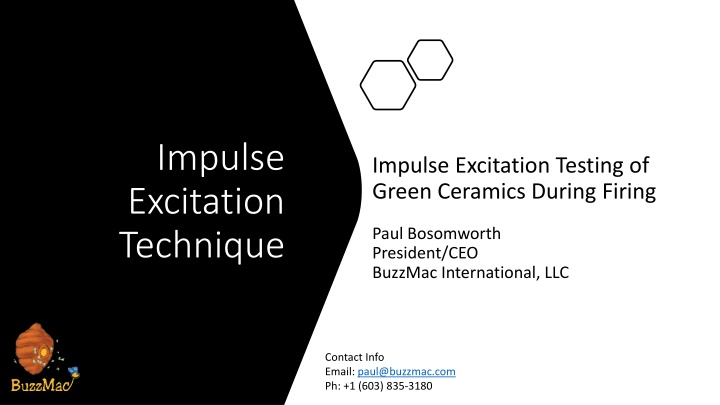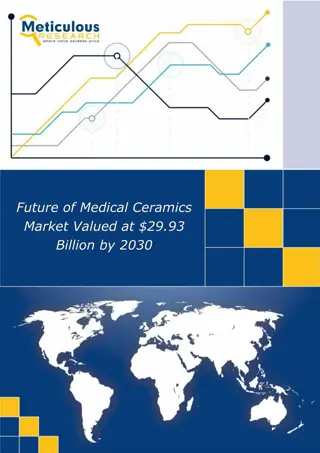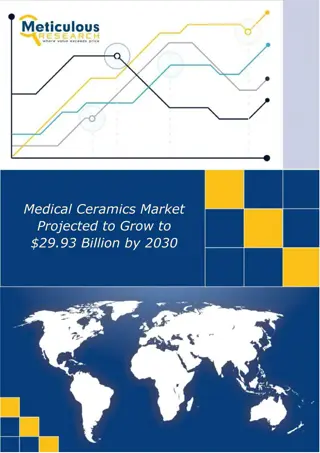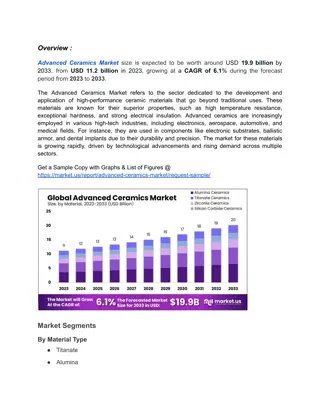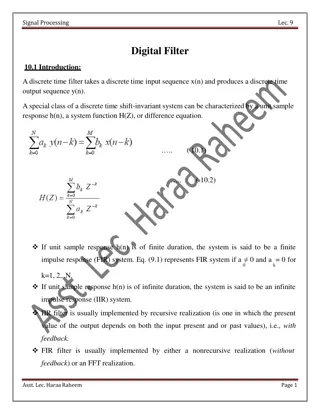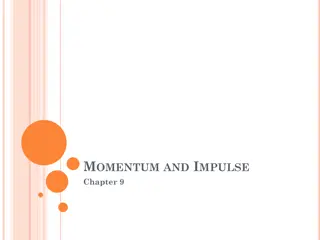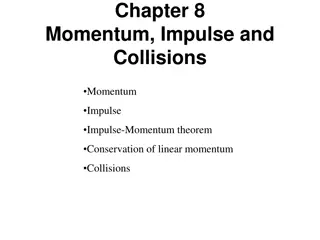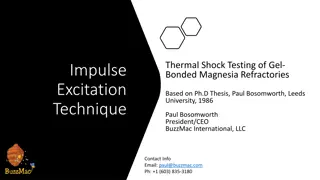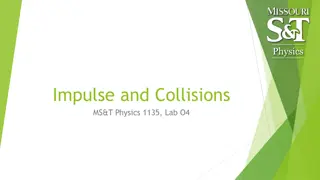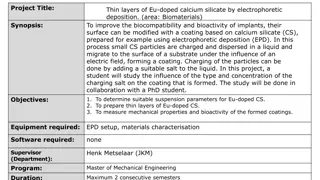Impulse Excitation Technique for Monitoring Green Ceramics During Firing
The Impulse Excitation Technique (IET) is a nondestructive testing method employed to monitor the elastic properties of green ceramics as they undergo firing processes. This technique allows for the analysis of phase changes and material behavior at high temperatures, providing valuable insights into the structural transformations occurring during the firing of ceramics. Results from flexural frequency measurements and thermal analyses demonstrate the correlation between elastic properties and phase transitions in green ceramics, offering a comprehensive understanding of the firing process. By combining various data sets, including flexural frequency, thermal analysis, and sintering mechanisms, the Impulse Excitation Technique proves to be a powerful tool for assessing the properties and behavior of ceramics under elevated temperatures.
Download Presentation

Please find below an Image/Link to download the presentation.
The content on the website is provided AS IS for your information and personal use only. It may not be sold, licensed, or shared on other websites without obtaining consent from the author.If you encounter any issues during the download, it is possible that the publisher has removed the file from their server.
You are allowed to download the files provided on this website for personal or commercial use, subject to the condition that they are used lawfully. All files are the property of their respective owners.
The content on the website is provided AS IS for your information and personal use only. It may not be sold, licensed, or shared on other websites without obtaining consent from the author.
E N D
Presentation Transcript
Impulse Excitation Technique Impulse Excitation Testing of Green Ceramics During Firing Paul Bosomworth President/CEO BuzzMac International, LLC Contact Info Email: paul@buzzmac.com Ph: +1 (603) 835-3180
Impulse Excitation Technique (IET)* at High Temperature TAP MEASURE VIBRATIONS RECORD & ANALYSE (damping/elastic properties) Ceramic *also known as ping test, resonant vibration, impact acoustic resonance, eigen frequency method
Introduction Only nondestructive testing (NDT) methods can be used to monitor the elastic properties of green ceramics as they are being fired. The impulse excitation technique (IET) was used to relate changes in elastic properties of a green quartz sample to the phase changes occurring during firing1. The setup is shown in figure 1 below. The sample was an extruded cylinder ( 11.73 mm x 113.97 mm) of a porcelain mixture (50 wt% kaolin, 25 wt% quartz and 25 wt% feldspar). The sample was heated to ~1100 C at a rate of 5 C/min in air. 1. Paul A. Bosomworth, " Monitoring the Elastic Properties of Green Ceramics during Firing," Ceramic Industry (February 2016) Figure 1: High temperature setup
Results The flexural frequency can be compared to some results from thermal analyses1,2. Figure 2: Flexural frequency vs. temperature Figure 3: Thermal analyses 1. Igor Stubna, Frantisek Chmel k, Anton Trn k, Josef Pesicka, Creation of microcracks in porcelain during firing, J Eur Ceram Soc. 31, pp. 2205 2209 (2011) 2. Igor Stubna, Frantisek Chmel k, Anton Trn k, Peter Sin, Acoustic emission study of quartz porcelain during heating up to 1150 C, Ceram Int, 38 pp. 6919 6922 (2012)
Discussion of Results By combining figures 2 and 3 and adding DTA data in figure 4, three main regions of interest are revealed: 1. Water physically bound to the pore surfaces in the sample begins to be driven off at ~ 50 C (TGA curve). 2. The kaolinite in the green body transforms into metakaolinite over the temperature range of 400- 700 C. Dehydroxilation takes place at ~420 C (DTA curve) with a concomitant mass loss (TGA curve). 3. The sample begins to shrink significantly above 893 C (TDA curve). Figure 4 The initial rise in frequency matches the onset of water loss (1), the second one matches the onset of the kaolinite metakaolinite dihydroxylation (2), and the final and rapid frequency rise matches the sample shrinkage (3). Sintering mechanisms will lead to more shrinkage and an increase in the flexural frequency. Other effects can be seen in the frequency curve: an inflection can be seen to match the - quartz inversion shown in the TDA/DTA curves. Solid state sintering, which occurs above ~600 C also gives rise to an increase in the flexural frequency in addition to that due to mass loss. Microcracking from phase changes etc. also affects the frequency curve.
Conclusions and Comments IET can be used over a variety of testing environments (high/low temperatures, humidity ) IET is ideally suited for measuring the changes in elastic properties during firing IET is fast, efficient and relatively low cost compared to destructive mechanical testing IET is suited to R&D, QC/QA Any question or comments, please contact me on linkedin.com/in/paul-bosomworth-78151514
